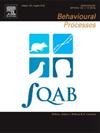导游对马亚动物园白掌长臂猿和卷尾猴福利的影响。
IF 1.3
4区 生物学
Q4 BEHAVIORAL SCIENCES
引用次数: 0
摘要
动物园的动物经常暴露在它们无法控制的大量感官刺激中,这可能对它们的行为和福利产生不利影响,包括不熟悉的面孔、过度的噪音和侵扰性的游客互动。动物园已经实施了各种措施,如丰富和规范游客的行为,以减轻这些影响。然而,导游并没有被用来同时控制游客的行为和维护动物的福利。本研究通过观察两种非人类灵长类动物——白掌长臂猿(Hylobates lar)和卷尾猴(Sapajus apella)在导游和自导导游条件下的灵长类动物行为以及游客的噪音和行为,研究了游客对它们行为的影响。主要目的是评估游客对动物福利的影响,并调查导游是否有助于控制游客不必要的噪音和行为。通过每次15分钟的瞬时采样间隔获得若干行为的观察数据。结果表明,在长臂猿的圈地中,与自游相比,有导游的游览具有较低的噪音水平(平均降低3.0dB)和较低的自我梳理频率。相反,卷尾猴在不同的旅行类型中表现出相似的行为反应,可能受到研究期间出生的婴儿的影响。尽管结果各不相同,但他们认为,导游可能会减少游客的噪音,并可能为动物提供一种熟悉的存在,因为导游的存在可能会影响福利结果。然而,福利增加的证据仍然没有定论。此外,将导游作为教育和保护措施,可以有效地吸引游客,确保动物园动物的福利。本文章由计算机程序翻译,如有差异,请以英文原文为准。
The influence of guided tours on the welfare of white-handed gibbons and capuchin monkeys at Maia Zoo
Zoo animals are regularly exposed to a plethora of sensorial stimuli beyond their control, which can adversely impact their behaviour and welfare, including unfamiliar faces, excessive noise and intrusive visitor interaction. Zoos have implemented various measures, such as enrichments and regulation of visitor behaviour, to mitigate these effects. However, guided tours have not been used to simultaneously control visitor behaviour and maintain animal welfare. In this study, we investigated how visitors influence the behaviour of two non-human primate species: white-handed gibbons (Hylobates lar) and capuchin monkeys (Sapajus apella), by observing primate behaviour and visitor noise and behaviour under guided and self-guided tour conditions. The main focus was to assess visitor impact on animal welfare and investigate whether guided tours helped regulate visitors’ unwanted noise and behaviour. Observational data on several behaviours were obtained through instantaneous sampling intervals lasting 15-minutes each. Results indicate that in the gibbons’ enclosure, guided tours, compared to self-guided tours, were associated with lower noise levels (mean reduction of 3.0 dB) and reduced self-grooming frequencies. Conversely, capuchin monkeys exhibited similar behavioural responses between tour types, likely influenced by the presence of an infant born during the study. Although results varied, they suggest guided tours might be associated to reduced visitor noise and may provide a familiar presence for the animals, due to the presence of a guide, which could potentially influence welfare outcomes. However, evidence of enhanced welfare remains inconclusive. Furthermore, integrating guided tours as educational and conservation initiatives could effectively engage visitors and ensure zoo animal welfare.
求助全文
通过发布文献求助,成功后即可免费获取论文全文。
去求助
来源期刊

Behavioural Processes
生物-动物学
CiteScore
2.70
自引率
7.70%
发文量
144
审稿时长
4-8 weeks
期刊介绍:
Behavioural Processes is dedicated to the publication of high-quality original research on animal behaviour from any theoretical perspective. It welcomes contributions that consider animal behaviour from behavioural analytic, cognitive, ethological, ecological and evolutionary points of view. This list is not intended to be exhaustive, and papers that integrate theory and methodology across disciplines are particularly welcome.
 求助内容:
求助内容: 应助结果提醒方式:
应助结果提醒方式:


